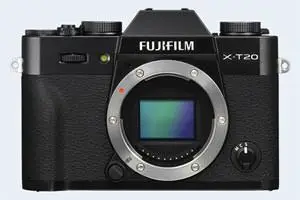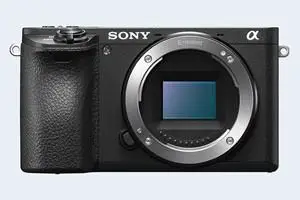Fujifilm X-T20 vs Sony A6500
The Fujifilm X-T20 and the Sony Alpha A6500 are two digital cameras that were officially introduced, respectively, in January 2017 and October 2016. Both the X-T20 and the A6500 are mirrorless interchangeable lens cameras that are equipped with an APS-C sensor. Both cameras offer a resolution of 24 megapixels.
Below is an overview of the main specs of the two cameras as a starting point for the comparison.

Check X-T20 offers at
ebay.com

Check A6500 offers at
ebay.com
Going beyond this snapshot of core features and characteristics, what are the differences between the Fujifilm X-T20 and the Sony Alpha A6500? Which one should you buy? Read on to find out how these two cameras compare with respect to their body size, their imaging sensors, their shooting features, their input-output connections, and their reception by expert reviewers.
Body comparison
An illustration of the physical size and weight of the Fujifilm X-T20 and the Sony A6500 is provided in the side-by-side display below. The two cameras are presented according to their relative size. Three successive views from the front, the top, and the rear are shown. All width, height and depth dimensions are rounded to the nearest millimeter.
The X-T20 can be obtained in two different colors (black, silver), while the A6500 is only available in black.
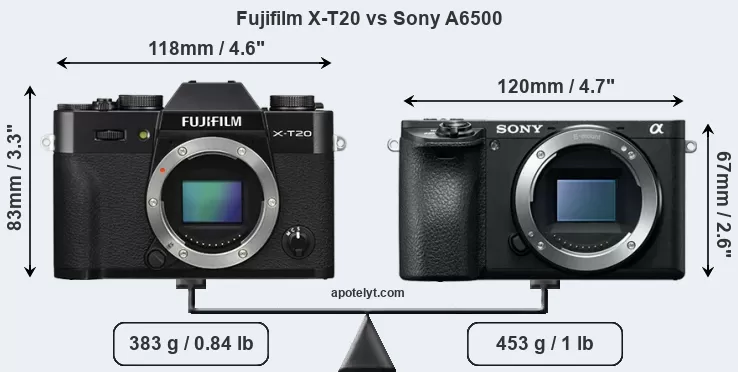

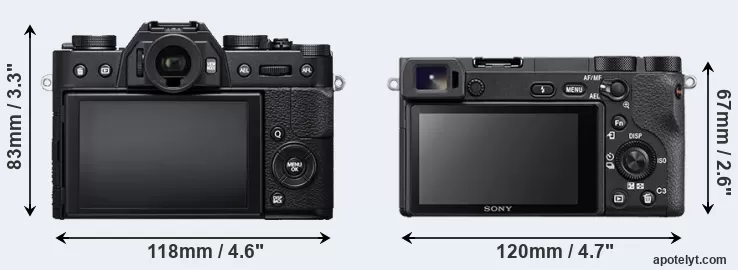
If the front view area (width x height) of the cameras is taken as an aggregate measure of their size, the Sony A6500 is notably smaller (18 percent) than the Fujifilm X-T20. However, the A6500 is markedly heavier (18 percent) than the X-T20. It is noteworthy in this context that the A6500 is splash and dust-proof, while the X-T20 does not feature any corresponding weather-sealing.
The above size and weight comparisons are to some extent incomplete since they do not consider the interchangeable lenses that both of these cameras require. Yet, since both cameras are based around an APS-C sensor, their respective lenses will tend to have similar dimensions and heft. You can compare the optics available for the two cameras in the Fujinon X Lens Catalog (X-T20) and the Sony E-Mount Lens Catalog (A6500). Mirrorless cameras, such as the two under consideration, have the additional advantage of having a short flange to focal plane distance, which makes it possible to mount many lenses from other systems onto the camera via adapters.
The battery packs of both cameras can be charged via USB, which can be very convenient when travelling.
The table below summarizes the key physical specs of the two cameras alongside a broader set of comparators. If you want to switch the focus of the display and review another camera pair, you can move across to the CAM-parator tool and choose from the broad selection of possible camera comparisons there.

| Camera Model |
Camera Width |
Camera Height |
Camera Depth |
Camera Weight |
Battery Life |
Weather Sealing |
Camera Launch |
Launch Price |
Street Price |
||
|---|---|---|---|---|---|---|---|---|---|---|---|
| 1. | Fujifilm X-T20 | 118 mm | 83 mm | 41 mm | 383 g | 350 | n | Jan 2017 | US$ 899 | ebay.com | |
| 2. | Sony A6500 | 120 mm | 67 mm | 53 mm | 453 g | 350 | Y | Oct 2016 | US$ 1 399 | ebay.com | |
| 3. | Fujifilm X-A3 | 117 mm | 67 mm | 40 mm | 339 g | 410 | n | Aug 2016 | US$ 399 | ebay.com | |
| 4. | Fujifilm X-A5 | 117 mm | 68 mm | 40 mm | 361 g | 450 | n | Jan 2018 | US$ 399 | ebay.com | |
| 5. | Fujifilm X-E2 | 129 mm | 75 mm | 37 mm | 350 g | 350 | n | Oct 2013 | US$ 999 | ebay.com | |
| 6. | Fujifilm X-E3 | 121 mm | 74 mm | 43 mm | 337 g | 350 | n | Sep 2017 | US$ 899 | ebay.com | |
| 7. | Fujifilm X-E4 | 121 mm | 73 mm | 33 mm | 364 g | 380 | n | Jan 2021 | US$ 849 | amazon.com | |
| 8. | Fujifilm X-T10 | 118 mm | 83 mm | 41 mm | 381 g | 350 | n | May 2015 | US$ 799 | ebay.com | |
| 9. | Fujifilm X-T30 | 118 mm | 83 mm | 47 mm | 383 g | 380 | n | Feb 2019 | US$ 899 | ebay.com | |
| 10. | Fujifilm X-T30 II | 118 mm | 83 mm | 47 mm | 383 g | 380 | n | Sep 2021 | US$ 899 | ebay.com | |
| 11. | Fujifilm X-T100 | 121 mm | 83 mm | 47 mm | 448 g | 430 | n | May 2018 | US$ 599 | ebay.com | |
| 12. | Fujifilm X70 | 113 mm | 64 mm | 44 mm | 340 g | 330 | n | Jan 2016 | US$ 799 | ebay.com | |
| 13. | Panasonic GX8 | 133 mm | 78 mm | 63 mm | 487 g | 330 | Y | Jul 2015 | US$ 1 199 | ebay.com | |
| 14. | Sony A77 | 143 mm | 104 mm | 81 mm | 732 g | 470 | Y | Aug 2011 | US$ 1 399 | ebay.com | |
| 15. | Sony A6300 | 120 mm | 67 mm | 49 mm | 404 g | 400 | Y | Feb 2016 | US$ 999 | ebay.com | |
| 16. | Sony A6600 | 120 mm | 67 mm | 69 mm | 503 g | 810 | Y | Aug 2019 | US$ 1 399 | amazon.com | |
| 17. | Sony A6700 | 122 mm | 69 mm | 64 mm | 493 g | 570 | Y | Jul 2023 | US$ 1 399 | amazon.com | |
| Note: Measurements and pricing do not include easily detachable parts, such as add-on or interchangeable lenses or optional viewfinders. | |||||||||||
The price is, of course, an important factor in any camera decision. The retail prices at the time of the camera’s release place the model in the market relative to other models in the producer’s line-up and the competition. The X-T20 was launched at a markedly lower price (by 36 percent) than the A6500, which puts it into a different market segment. Usually, retail prices stay at first close to the launch price, but after several months, discounts become available. Later in the product cycle and, in particular, when the replacement model is about to appear, further discounting and stock clearance sales often push the camera price considerably down.
Sensor comparison
The imaging sensor is at the core of digital cameras and its size is one of the main determining factors of image quality. A large sensor will generally have larger individual pixels that offer better low-light sensitivity, provide wider dynamic range, and have richer color-depth than smaller pixels in a sensor of the same technological generation. Moreover, a large sensor camera will give the photographer more control over depth-of-field in the image and, thus, the ability to better isolate a subject from the background. On the downside, larger sensors tend to be associated with larger, more expensive camera bodies and lenses.
Both cameras under consideration feature an APS-C sensor, but their sensors differ slightly in size. They nevertheless have the same format factor of 1.5. Both cameras have a native aspect ratio (sensor width to sensor height) of 3:2.
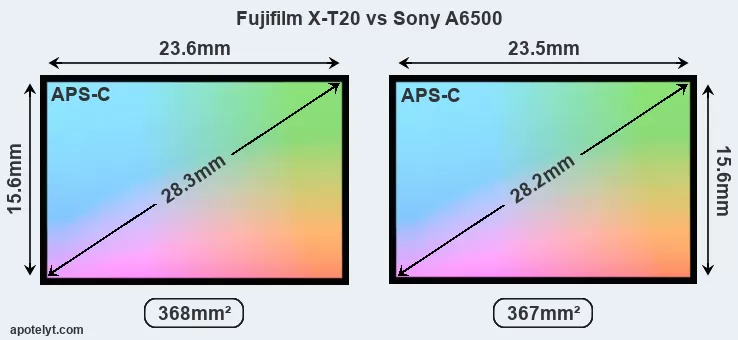
Even though the X-T20 has a slightly larger sensor, both cameras offer the same resolution of 24 megapixels. This implies that the X-T20 has a lower pixel density and larger individual pixels (with a pixel pitch of 3.92μm versus 3.91μm for the A6500), which gives it a potential advantage in terms of light gathering capacity. In addition, the X-T20 is a somewhat more recent model (by 3 months) than the A6500, and its sensor might have benefitted from technological advances during this time. Coming back to sensor resolution, it should be mentioned that the X-T20 has no anti-alias filter installed, so that it can capture all the detail its sensor resolves.
The Fujifilm X-T20 has a native sensitivity range from ISO 200 to ISO 12800, which can be extended to ISO 100-51200. The corresponding ISO settings for the Sony Alpha A6500 are ISO 100 to ISO 25600, with the possibility to increase the ISO range to 100-51200.
Technology-wise, both cameras are equipped with CMOS (Complementary Metal–Oxide–Semiconductor) sensors. The X-T20 uses Fujifilm's X-Trans layout of photosites, while the A6500 employs the more common Bayer array.
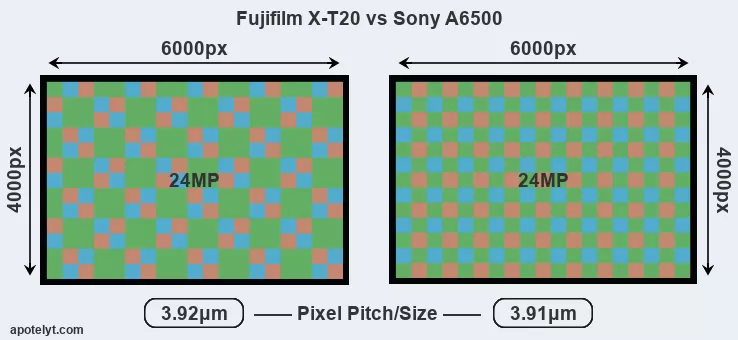
Consistent information on actual sensor performance is available from DXO Mark for many cameras. This service assesses and scores the color depth ("DXO Portrait"), dynamic range ("DXO Landscape"), and low-light sensitivity ("DXO Sports") of camera sensors, and also publishes an overall camera score. The table below summarizes the physical sensor characteristics and sensor quality findings and compares them across a set of similar cameras.

| Camera Model |
Sensor Class |
Resolution (MP) |
Horiz. Pixels |
Vert. Pixels |
Video Format |
DXO Portrait |
DXO Landscape |
DXO Sports |
DXO Overall |
||
|---|---|---|---|---|---|---|---|---|---|---|---|
| 1. | Fujifilm X-T20 | APS-C | 24.0 | 6000 | 4000 | 4K/30p | 23.9 | 13.2 | 1704 | 81 | |
| 2. | Sony A6500 | APS-C | 24.0 | 6000 | 4000 | 4K/30p | 24.5 | 13.7 | 1405 | 85 | |
| 3. | Fujifilm X-A3 | APS-C | 24.0 | 6000 | 4000 | 1080/60p | 23.8 | 13.1 | 1664 | 81 | |
| 4. | Fujifilm X-A5 | APS-C | 24.0 | 6000 | 4000 | 4K/15p | 24.0 | 13.3 | 1800 | 82 | |
| 5. | Fujifilm X-E2 | APS-C | 16.0 | 4896 | 3264 | 1080/60p | 23.4 | 12.6 | 1400 | 77 | |
| 6. | Fujifilm X-E3 | APS-C | 24.0 | 6000 | 4000 | 4K/30p | 23.9 | 13.3 | 1764 | 82 | |
| 7. | Fujifilm X-E4 | APS-C | 26.0 | 6240 | 4160 | 4K/30p | 24.2 | 13.7 | 2085 | 85 | |
| 8. | Fujifilm X-T10 | APS-C | 16.0 | 4896 | 3264 | 1080/60p | 23.7 | 12.9 | 1546 | 79 | |
| 9. | Fujifilm X-T30 | APS-C | 26.0 | 6240 | 4160 | 4K/30p | 24.1 | 13.5 | 1895 | 83 | |
| 10. | Fujifilm X-T30 II | APS-C | 26.0 | 6240 | 4160 | 4K/30p | 24.2 | 13.8 | 2144 | 85 | |
| 11. | Fujifilm X-T100 | APS-C | 24.0 | 6000 | 4000 | 4K/15p | 24.0 | 13.4 | 1829 | 83 | |
| 12. | Fujifilm X70 | APS-C | 16.0 | 4896 | 3264 | 1080/60p | 23.7 | 13.0 | 1608 | 80 | |
| 13. | Panasonic GX8 | Four Thirds | 20.2 | 5184 | 3888 | 4K/30p | 23.5 | 12.6 | 806 | 75 | |
| 14. | Sony A77 | APS-C | 24.0 | 6000 | 4000 | 1080/60p | 24.0 | 13.2 | 801 | 78 | |
| 15. | Sony A6300 | APS-C | 24.0 | 6000 | 4000 | 4K/30p | 24.4 | 13.7 | 1437 | 85 | |
| 16. | Sony A6600 | APS-C | 24.0 | 6000 | 4000 | 4K/30p | 23.8 | 13.4 | 1497 | 82 | |
| 17. | Sony A6700 | APS-C | 25.6 | 6192 | 4128 | 4K/120p | 24.3 | 14.0 | 2329 | 86 | |
| Note: DXO values in italics represent estimates based on sensor size and age. | |||||||||||
Many modern cameras are not only capable of taking still images, but also of capturing video footage. Both cameras under consideration have a sensor with sufficiently fast read-out times for moving pictures, and both provide the same movie specifications (4K/30p).
Feature comparison
Beyond body and sensor, cameras can and do differ across a range of features. The two cameras under consideration are similar with respect to both having an electronic viewfinder. However, the one in the X-T20 offers a slightly higher resolution than the one in the A6500 (2360k vs 2359k dots). The adjacent table lists some of the other core features of the Fujifilm X-T20 and Sony A6500 along with similar information for a selection of comparators.

| Camera Model |
Viewfinder (Type or 000 dots) |
Control Panel (yes/no) |
LCD Specifications (inch/000 dots) |
LCD Attach- ment |
Touch Screen (yes/no) |
Max Shutter Speed * |
Max Shutter Flaps * |
Built-in Flash (yes/no) |
Built-in Image Stab |
||
|---|---|---|---|---|---|---|---|---|---|---|---|
| 1. | Fujifilm X-T20 | 2360 | n | 3.0 / 1040 | tilting | Y | 1/4000s | 8.0/s | Y | n | |
| 2. | Sony A6500 | 2359 | n | 3.0 / 922 | tilting | Y | 1/4000s | 11.0/s | Y | Y | |
| 3. | Fujifilm X-A3 | none | n | 3.0 / 1040 | tilting | Y | 1/4000s | 6.0/s | Y | n | |
| 4. | Fujifilm X-A5 | none | n | 3.0 / 1040 | tilting | Y | 1/4000s | 6.0/s | Y | n | |
| 5. | Fujifilm X-E2 | 2360 | n | 3.0 / 1040 | fixed | n | 1/4000s | 7.0/s | Y | n | |
| 6. | Fujifilm X-E3 | 2360 | n | 3.0 / 1040 | fixed | Y | 1/4000s | 8.0/s | n | n | |
| 7. | Fujifilm X-E4 | 2360 | n | 3.0 / 1620 | tilting | Y | 1/4000s | 8.0/s | n | n | |
| 8. | Fujifilm X-T10 | 2360 | n | 3.0 / 920 | tilting | n | 1/4000s | 8.0/s | Y | n | |
| 9. | Fujifilm X-T30 | 2360 | n | 3.0 / 1040 | tilting | Y | 1/4000s | 8.0/s | Y | n | |
| 10. | Fujifilm X-T30 II | 2360 | n | 3.0 / 1620 | tilting | Y | 1/4000s | 8.0/s | Y | n | |
| 11. | Fujifilm X-T100 | 2360 | n | 3.0 / 1040 | swivel | Y | 1/4000s | 6.0/s | Y | n | |
| 12. | Fujifilm X70 | optional | n | 3.0 / 1040 | tilting | Y | 1/4000s | 8.0/s | Y | n | |
| 13. | Panasonic GX8 | 2360 | n | 3.0 / 1040 | swivel | Y | 1/8000s | 10.0/s | n | Y | |
| 14. | Sony A77 | 2359 | Y | 3.0 / 921 | full-flex | n | 1/8000s | 12.0/s | Y | Y | |
| 15. | Sony A6300 | 2359 | n | 3.0 / 922 | tilting | n | 1/4000s | 11.0/s | Y | n | |
| 16. | Sony A6600 | 2359 | n | 3.0 / 922 | tilting | Y | 1/4000s | 11.0/s | n | Y | |
| 17. | Sony A6700 | 2360 | n | 3.0 / 1037 | swivel | Y | 1/4000s | 11.0/s | n | Y | |
| Note: *) Information refers to the mechanical shutter, unless the camera only has an electronic one. | |||||||||||
One feature that differentiates the A6500 and the X-T20 is in-body image stabilization (IBIS). The A6500 reduces the risk of handshake-induced blur with all attached lenses, while the X-T20 offers no blur reduction with lenses that themselves do not provide optical image stabilization.
The reported shutter speed information refers to the use of the mechanical shutter. Yet, some cameras only have an electronic shutter, while others have an electronic shutter in addition to a mechanical one. In fact, both cameras under consideration feature an electronic shutter, which makes completely silent shooting possible. However, this mode is less suitable for photographing moving objects (risk of rolling shutter) or shooting under artificial light sources (risk of flickering).
The Fujifilm X-T20 has an intervalometer built-in. This enables the photographer to capture time lapse sequences, such as flower blooming, a sunset or moon rise, without purchasing an external camera trigger and related software.
The X-T20 writes its imaging data to SDXC cards, while the A6500 uses SDXC or Memory Stick PRO Duo cards. Both cameras can use UHS-I cards, which provide for Ultra High Speed data transfer of up to 104 MB/s.
Connectivity comparison
For some imaging applications, the extent to which a camera can communicate with its environment can be an important aspect in the camera decision process. The table below provides an overview of the connectivity of the Fujifilm X-T20 and Sony Alpha A6500 and, in particular, the interfaces the cameras (and selected comparators) provide for accessory control and data transfer.

| Camera Model |
Hotshoe Port |
Internal Mic / Speaker |
Microphone Port |
Headphone Port |
HDMI Port |
USB Port |
WiFi Support |
NFC Support |
Bluetooth Support |
||
|---|---|---|---|---|---|---|---|---|---|---|---|
| 1. | Fujifilm X-T20 | Y | stereo / mono | Y | - | micro | 2.0 | Y | - | - | |
| 2. | Sony A6500 | Y | stereo / mono | Y | - | micro | 2.0 | Y | Y | - | |
| 3. | Fujifilm X-A3 | Y | stereo / mono | - | - | micro | 2.0 | Y | - | - | |
| 4. | Fujifilm X-A5 | Y | stereo / mono | Y | - | micro | 2.0 | Y | - | Y | |
| 5. | Fujifilm X-E2 | Y | stereo / mono | Y | - | micro | 2.0 | Y | - | - | |
| 6. | Fujifilm X-E3 | Y | stereo / mono | Y | - | micro | 2.0 | Y | - | Y | |
| 7. | Fujifilm X-E4 | Y | stereo / mono | Y | - | micro | 3.2 | Y | - | Y | |
| 8. | Fujifilm X-T10 | Y | stereo / mono | Y | - | micro | 2.0 | Y | - | - | |
| 9. | Fujifilm X-T30 | Y | stereo / mono | Y | - | micro | 3.1 | Y | - | Y | |
| 10. | Fujifilm X-T30 II | Y | stereo / mono | Y | - | micro | 3.2 | Y | - | Y | |
| 11. | Fujifilm X-T100 | Y | stereo / mono | Y | - | micro | 2.0 | Y | - | Y | |
| 12. | Fujifilm X70 | Y | stereo / mono | Y | - | micro | 2.0 | Y | - | - | |
| 13. | Panasonic GX8 | Y | stereo / mono | Y | - | micro | 2.0 | Y | Y | - | |
| 14. | Sony A77 | Y | stereo / mono | Y | - | mini | 2.0 | - | - | - | |
| 15. | Sony A6300 | Y | stereo / mono | Y | - | micro | 2.0 | Y | Y | - | |
| 16. | Sony A6600 | Y | stereo / mono | Y | Y | YES | 2.0 | Y | Y | Y | |
| 17. | Sony A6700 | Y | stereo / mono | Y | Y | YES | 3.2 | Y | Y | Y |
Both the X-T20 and the A6500 have been discontinued, but can regularly be found used on ebay. The A6500 was replaced by the Sony A6600, while the X-T20 was followed by the Fujifilm X-T100. Further information on the features and operation of the X-T20 and A6500 can be found, respectively, in the Fujifilm X-T20 Manual (free pdf) or the online Sony A6500 Manual.
Review summary
So what is the bottom line? Is the Fujifilm X-T20 better than the Sony A6500 or vice versa? Below is a summary of the relative strengths of each of the two contestants.

Advantages of the Fujifilm X-T20:
- Maximized detail: Lacks an anti-alias filter to exploit the sensor's full resolution potential.
- More detailed LCD: Has a higher resolution rear screen (1040k vs 922k dots).
- Easier time-lapse photography: Has an intervalometer built-in for low frequency shooting.
- Less heavy: Is lighter (by 70g or 15 percent) and hence easier to carry around.
- More affordable: Was introduced into a lower priced category (36 percent cheaper at launch).
- More modern: Is somewhat more recent (announced 3 months after the A6500).

Arguments in favor of the Sony Alpha A6500:
- Better moiré control: Has an anti-alias filter to avoid artificial patterns to appear in images.
- Larger viewfinder image: Features a viewfinder with a higher magnification (0.70x vs 0.62x).
- Faster burst: Shoots at higher frequency (11 vs 8 flaps/sec) to capture the decisive moment.
- More compact: Is smaller (120x67mm vs 118x83mm) and will fit more readily into a bag.
- Better sealing: Is splash and dust sealed for shooting in inclement weather conditions.
- Sharper images: Has stabilization technology built-in to reduce the impact of hand-shake.
- Easier device pairing: Supports NFC for fast wireless image transfer over short distances.
- More heavily discounted: Has been on the market for longer (launched in October 2016).
If the count of individual advantages (bullet points above) is taken as a guide, the A6500 emerges as the winner of the match-up (8 : 6 points). However, the relative importance of the various individual camera aspects will vary according to personal preferences and needs, so that you might like to apply corresponding weights to the particular features before making a decision on a new camera. A professional wedding photographer will view the differences between cameras in a way that diverges from the perspective of a travel photog, and a person interested in cityscapes has distinct needs from a macro shooter. Hence, the decision which camera is best and worth buying is often a very personal one.
How about other alternatives? Do the specifications of the Fujifilm X-T20 and the Sony A6500 place the cameras among the top in their class? Find out in the latest Best Mirrorless Interchangeable Lens Camera listing whether the two cameras rank among the cream of the crop.
In any case, while the specs-based evaluation of cameras can be instructive in revealing their potential as photographic tools, it says little about, for example, the shooting experience and imaging performance of the X-T20 and the A6500 in practical situations. User reviews, such as those found at amazon, can sometimes inform about these issues, but such feedback is often incomplete, inconsistent, and biased.
Expert reviews
This is why hands-on reviews by experts are important. The adjacent summary-table relays the overall verdicts of several of the most popular camera review sites (amateurphotographer [AP], cameralabs [CL], digitalcameraworld [DCW], dpreview [DPR], ephotozine [EPZ], photographyblog [PB]). As can be seen, the professional reviewers agree in many cases on the quality of different cameras, but sometimes their assessments diverge, reinforcing the earlier point that a camera decision is often a very personal choice.

| Camera Model |
AP score |
CL score |
DCW score |
DPR score |
EPZ score |
PB score |
Camera Launch |
Launch Price |
Street Price |
||
|---|---|---|---|---|---|---|---|---|---|---|---|
| 1. | Fujifilm X-T20 | 5/5 | + + | 5/5 | 82/100 | 5/5 | 4.5/5 | Jan 2017 | US$ 899 | ebay.com | |
| 2. | Sony A6500 | 5/5 | + + | 3.5/5 | 85/100 | 4.5/5 | 4.5/5 | Oct 2016 | US$ 1 399 | ebay.com | |
| 3. | Fujifilm X-A3 | .. | .. | .. | 74/100 | 4.5/5 | 4/5 | Aug 2016 | US$ 399 | ebay.com | |
| 4. | Fujifilm X-A5 | .. | + | 4.1/5 | .. | 4/5 | 3.5/5 | Jan 2018 | US$ 399 | ebay.com | |
| 5. | Fujifilm X-E2 | 4/5 | .. | .. | 80/100 | 4.5/5 | 5/5 | Oct 2013 | US$ 999 | ebay.com | |
| 6. | Fujifilm X-E3 | 4.5/5 | + | 4.5/5 | 84/100 | 4.5/5 | 4.5/5 | Sep 2017 | US$ 899 | ebay.com | |
| 7. | Fujifilm X-E4 | 4/5 | .. | 4/5 | .. | 4.5/5 | 4/5 | Jan 2021 | US$ 849 | amazon.com | |
| 8. | Fujifilm X-T10 | 4.5/5 | + + | .. | 80/100 | 5/5 | 5/5 | May 2015 | US$ 799 | ebay.com | |
| 9. | Fujifilm X-T30 | 5/5 | + + | 5/5 | 84/100 | 4.5/5 | 4.5/5 | Feb 2019 | US$ 899 | ebay.com | |
| 10. | Fujifilm X-T30 II | 5/5 | .. | 4/5 | .. | 4.5/5 | 4.5/5 | Sep 2021 | US$ 899 | ebay.com | |
| 11. | Fujifilm X-T100 | 4/5 | + | 4.5/5 | 79/100 | 4/5 | 4.5/5 | May 2018 | US$ 599 | ebay.com | |
| 12. | Fujifilm X70 | 4.5/5 | .. | .. | 76/100 | 4.5/5 | 4.5/5 | Jan 2016 | US$ 799 | ebay.com | |
| 13. | Panasonic GX8 | 5/5 | + | .. | 82/100 | 4.5/5 | 4.5/5 | Jul 2015 | US$ 1 199 | ebay.com | |
| 14. | Sony A77 | 5/5 | 91/100 | .. | 81/100 | .. | 5/5 | Aug 2011 | US$ 1 399 | ebay.com | |
| 15. | Sony A6300 | 4.5/5 | + | .. | 85/100 | 5/5 | 5/5 | Feb 2016 | US$ 999 | ebay.com | |
| 16. | Sony A6600 | 4/5 | + | 4/5 | 83/100 | 4.5/5 | 4/5 | Aug 2019 | US$ 1 399 | amazon.com | |
| 17. | Sony A6700 | 4.5/5 | + | 4.5/5 | 88/100 | 4.5/5 | 4.5/5 | Jul 2023 | US$ 1 399 | amazon.com | |
| Note: (+ +) highly recommended; (+) recommended; (o) reviewed; (..) not available. | |||||||||||
Care should be taken when interpreting the review scores above, though. The assessments were made in relation to similar cameras of the same technological generation. A score, therefore, has to be seen in close connection to the price and market introduction time of the camera, and comparing ratings of very distinct cameras or ones that are far apart in terms of their release date have little meaning. It should also be noted that some of the review sites have over time altered the way they render their verdicts.

Check X-T20 offers at
ebay.com

Check A6500 offers at
ebay.com
Other camera comparisons
Did this review help to inform your camera decision process? In case you would like to check on the differences and similarities of other camera models, just use the search menu below. As an alternative, you can also directly jump to any one of the listed comparisons that were previously generated by the CAM-parator tool.
- Canon SL3 vs Sony A6500
- Canon T3i vs Fujifilm X-T20
- Fujifilm X-T20 vs Fujifilm X100VI
- Fujifilm X-T20 vs Nikon D700
- Fujifilm X-T20 vs Panasonic GH2
- Fujifilm X-T20 vs Sony H400
- Fujifilm X-T20 vs Sony RX10 II
- Fujifilm XP140 vs Sony A6500
- Nikon D800E vs Sony A6500
- Olympus E-P2 vs Sony A6500
- Olympus E-P7 vs Sony A6500
- Sony A6500 vs Sony ZV-E10
Specifications: Fujifilm X-T20 vs Sony A6500
Below is a side-by-side comparison of the specs of the two cameras to facilitate a quick review of their differences and common features.
| Camera Model | Fujifilm X-T20 | Sony A6500 |
|---|---|---|
| Camera Type | Mirrorless system camera | Mirrorless system camera |
| Camera Lens | Fujifilm X mount lenses | Sony E mount lenses |
| Launch Date | January 2017 | October 2016 |
| Launch Price | USD 899 | USD 1,399 |
| Sensor Specs | Fujifilm X-T20 | Sony A6500 |
| Sensor Technology | CMOS | CMOS |
| Sensor Format | APS-C Sensor | APS-C Sensor |
| Sensor Size | 23.6 x 15.6 mm | 23.5 x 15.6 mm |
| Sensor Area | 368.16 mm2 | 366.6 mm2 |
| Sensor Diagonal | 28.3 mm | 28.2 mm |
| Crop Factor | 1.5x | 1.5x |
| Sensor Resolution | 24 Megapixels | 24 Megapixels |
| Image Resolution | 6000 x 4000 pixels | 6000 x 4000 pixels |
| Pixel Pitch | 3.92 μm | 3.91 μm |
| Pixel Density | 6.52 MP/cm2 | 6.55 MP/cm2 |
| Moiré control | no AA filter | Anti-Alias filter |
| Movie Capability | 4K/30p Video | 4K/30p Video |
| ISO Setting | 200 - 12,800 ISO | 100 - 25,600 ISO |
| ISO Boost | 100 - 51,200 ISO | 100 - 51,200 ISO |
| Image Processor | X-Processor Pro2 | BIONZ X |
| DXO Sensor Quality (score) | .. | 85 |
| DXO Color Depth (bits) | .. | 24.5 |
| DXO Dynamic Range (EV) | .. | 13.7 |
| DXO Low Light (ISO) | .. | 1405 |
| Screen Specs | Fujifilm X-T20 | Sony A6500 |
| Viewfinder Type | Electronic viewfinder | Electronic viewfinder |
| Viewfinder Field of View | 100% | 100% |
| Viewfinder Magnification | 0.62x | 0.70x |
| Viewfinder Resolution | 2360k dots | 2359k dots |
| LCD Framing | Live View | Live View |
| Rear LCD Size | 3.0inch | 3.0inch |
| LCD Resolution | 1040k dots | 922k dots |
| LCD Attachment | Tilting screen | Tilting screen |
| Touch Input | Touchscreen | Touchscreen |
| Shooting Specs | Fujifilm X-T20 | Sony A6500 |
| Focus System | On-Sensor Phase-detect | On-Sensor Phase-detect |
| Manual Focusing Aid | Focus Peaking | Focus Peaking |
| Max Shutter Speed (mechanical) | 1/4000s | 1/4000s |
| Continuous Shooting | 8 shutter flaps/s | 11 shutter flaps/s |
| Electronic Shutter | up to 1/32000s | YES |
| Time-Lapse Photography | Intervalometer built-in | no Intervalometer |
| Image Stabilization | Lens stabilization only | In-body stabilization |
| Fill Flash | Built-in Flash | Built-in Flash |
| Storage Medium | SDXC cards | MS or SDXC cards |
| Single or Dual Card Slots | Single card slot | Single card slot |
| UHS card support | UHS-I | UHS-I |
| Connectivity Specs | Fujifilm X-T20 | Sony A6500 |
| External Flash | Hotshoe | Hotshoe |
| USB Connector | USB 2.0 | USB 2.0 |
| HDMI Port | micro HDMI | micro HDMI |
| Microphone Port | External MIC port | External MIC port |
| Wifi Support | Wifi built-in | Wifi built-in |
| Near-Field Communication | no NFC | NFC built-in |
| Body Specs | Fujifilm X-T20 | Sony A6500 |
| Environmental Sealing | not weather sealed | Weathersealed body |
| Battery Type | Fujifilm NP-W126S | Sony NP-FW50 |
| Battery Life (CIPA) | 350 shots per charge | 350 shots per charge |
| In-Camera Charging | USB charging | USB charging |
| Body Dimensions |
118 x 83 x 41 mm (4.6 x 3.3 x 1.6 in) |
120 x 67 x 53 mm (4.7 x 2.6 x 2.1 in) |
| Camera Weight | 383 g (13.5 oz) | 453 g (16.0 oz) |

Check X-T20 offers at
ebay.com

Check A6500 offers at
ebay.com
Did you notice an error on this page? If so, please get in touch, so that we can correct the information.
